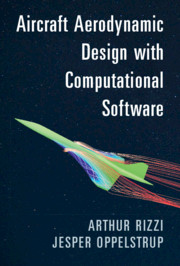Book contents
- Frontmatter
- Contents
- List of Figures
- List of Tables
- Preface
- Acknowledgements
- Abbreviations
- Nomenclature
- 1 Introduction to Aircraft Aerodynamic Design
- 2 Airflow Physics and Mathematical Models
- 3 Concepts and Computational Models in Wing Design
- 4 Finite-Volume Schemes for the Euler Equations
- 5 Airframe Computer-Aided Design and Automated Grid Generation
- 6 Computational Fluid Dynamics for Steady and Unsteady Flows
- 7 Fast Computation of Airfoil Flow
- 8 Airfoil Design Considerations
- 9 Wing Design Considerations
- 10 Configuration Development and Flying Qualities
- 11 Airload–Structure Interactions and Aero–Elastic Effects
- Index
5 - Airframe Computer-Aided Design and Automated Grid Generation
Published online by Cambridge University Press: 30 April 2021
- Frontmatter
- Contents
- List of Figures
- List of Tables
- Preface
- Acknowledgements
- Abbreviations
- Nomenclature
- 1 Introduction to Aircraft Aerodynamic Design
- 2 Airflow Physics and Mathematical Models
- 3 Concepts and Computational Models in Wing Design
- 4 Finite-Volume Schemes for the Euler Equations
- 5 Airframe Computer-Aided Design and Automated Grid Generation
- 6 Computational Fluid Dynamics for Steady and Unsteady Flows
- 7 Fast Computation of Airfoil Flow
- 8 Airfoil Design Considerations
- 9 Wing Design Considerations
- 10 Configuration Development and Flying Qualities
- 11 Airload–Structure Interactions and Aero–Elastic Effects
- Index
Summary
Computational fluid dynamics (CFD) requires a computational mesh: a subdivision of the flow region into millions of computational “cells” as a basis for making a computationally feasible discrete mathematical representations of the governing partial differential equation (PDE). Tools are needed to make a computerized geometric model of the aircraft skin, possibly extended by details of propulsion – propeller disks, jet engine intakes, and exhausts. Once the airframe geometry is defined, its exterior volume must be subdivided into small cells – the computational grid or mesh – for the numerical solution of the PDE. This was a trivial task for the 1D nozzle problem, but grid generation for detailed configurations is very demanding of the engineer's time. This chapter presents relevant details of computational geometry applied to the representation and manipulation of aircraft surfaces. The tutorial Surface Modeler indicates how this is done with open-source software. Intended to be a fail-safe unsupervisedtool in algorithmic shape optimization, automated grid generation is currently becoming a reality. This chapter uses the Sumo and TetGen tools, which take a geometry description format, specialized for aircraft, into a high-quality grid for Euler CFD, demonstrated in hands-on tutorials with many examples of generated grids.
Keywords
Information
- Type
- Chapter
- Information
- Aircraft Aerodynamic Design with Computational Software , pp. 179 - 212Publisher: Cambridge University PressPrint publication year: 2021
